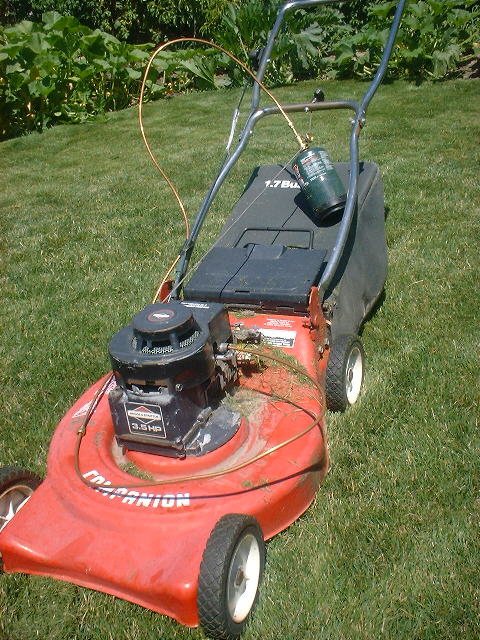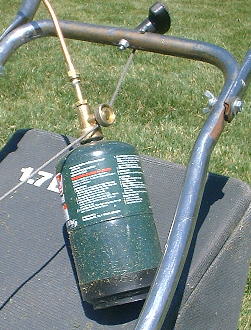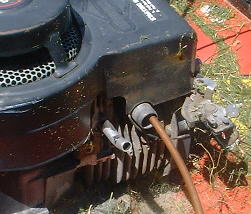

This experiment is certainly not a recommended method of converting a gasoline engine to run on propane but, it certainly was fun and it did provide a high level of satisfaction. It is of course an experiment that is best done out of doors.
The maximum RPM attainable with propane (or any alternate fuel) is an unknown factor. One must be careful with the throttle to prevent the engine from running faster than the maximum RPM that it was designed for.
With my first experiment of simply shooting propane into the intake, the engine ran so well that I was able to easily mow the whole 625 square foot lawn (I might add, a thick healthy robust lawn). The engine ran very smoothly, as well or better than it ever has, and had plenty of power. I actually felt that the engine could possibly develop more RPM than it was designed for so I was careful no to push the throttle too much. The aspects of a lawnmower cutting blade flying apart, is definitely not something that I wanted to include in this experiment.
If you want to know how efficiently it was using the propane, you are reading the wrong article. I don't know. I am much more fascinated with making things work than with making things efficient. The propane cannister shown in the pictures though, turned out to be more than enough to mow the 625 square foot lawn.


A 1/4 inch flare fitting was soldered onto the cut off end of the valve, making it possible to connect to a piece of copper tubing that was already around. I did this because the copper tube already had a 1/4 inch flare and fitting on it's end. There are many ways however that this copper tube could have been connected to the valve. It is also very likely that a piece of plastic tubing could work just as well as the copper tubing.
I had best results running the engine with the can of propane upright (running propane in the gaseous form into the tube). I did not get the engine to run when using the propane can upside down (running propane in liquid form into the tube). When doing this the copper tube became frozen and it was difficult to get gaseous propane into the intake.
To start the engine, the valve is opened slightly and the starting rope is pulled. The process of opening the valve a little more and pulling the rope is repeated until the engine starts. Once started, the valve can be used as a throttle. The valve should not be opened too far as this would allow too much propane to flow, causing the engine to stop.
This lawnmower has a history of not being able to idle well. This made it difficult to fully evaluate how well the engine could idle with this setup. I was however, able to control the speed over a wide range by carefully manipulating the valve. A more refined conversion procedure would at least include a pressure regulator and an air intake filter.